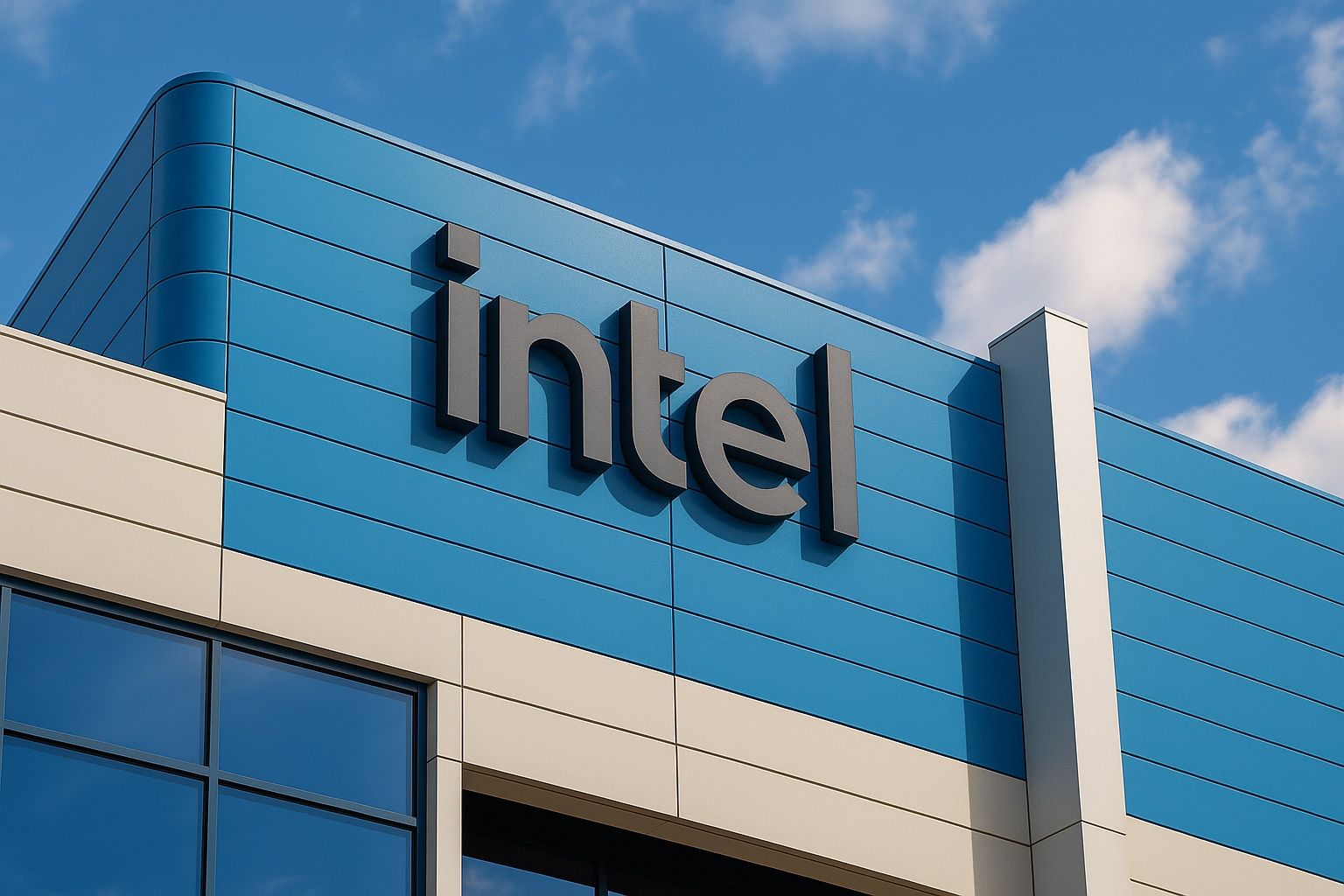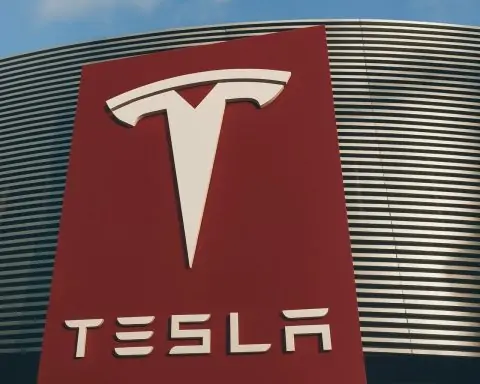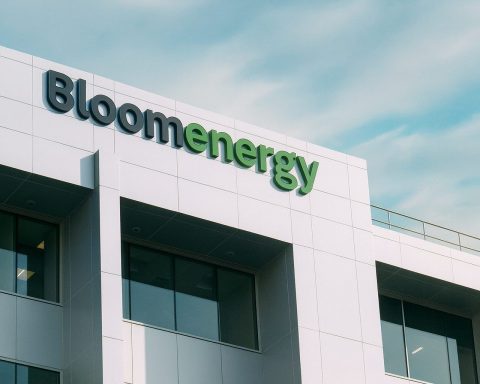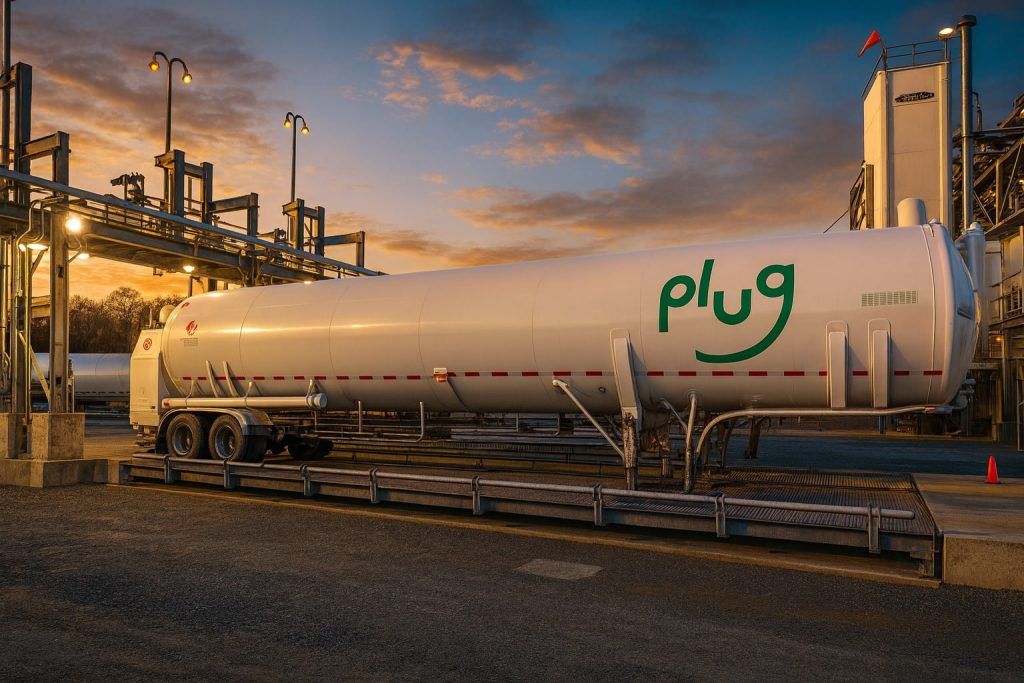- Stunning 2025 Rally: Intel’s stock (NASDAQ: INTC) has nearly doubled in 2025 – up about 85–90% year-to-date – far outpacing the S&P 500 and rival chip stocks like Nvidia and AMD [1] [2]. Shares recently hit an 18-month high around $39–$42, trading near their highest level since early 2024, after a surprise return to profitability in Q3 [3]. As of Oct. 30, 2025, INTC hovers around the mid-$40s, reflecting massive gains from its sub-$20 lows in January.
- Q3 Earnings Beat: Intel swung back to profit in Q3 2025, posting $13.7 billion in revenue (3% YoY growth) and adjusted EPS of $0.23 – far above the ~$0.01 expected [4] [5]. Aggressive cost cuts lifted gross margins to ~40% (beating ~36% consensus) [6], and Intel reported a $4 billion net profit after a steep loss a year ago. The earnings surprise and improving margins sparked a 7–8% surge in Intel’s stock after the report [7], bolstering confidence that the company’s turnaround is gaining traction.
- $15 Billion Lifeline: A trio of unprecedented strategic investments in 2025 injected $15 billion into Intel, providing a crucial lifeline. The U.S. government took a ~10% stake ( ~$8.9 B) in Intel as part of the CHIPS Act initiative [8] [9], aiming to ensure a domestic champion in advanced chips. In a surprise industry alliance, Nvidia invested $5 B for ~4% of Intel [10] to co-develop next-gen AI semiconductors, and Japan’s SoftBank bought ~$2 B (≈2% stake) via its Vision Fund [11] [12]. These backers have “offered a lifeline to the stock,” as Reuters noted, signaling confidence in Intel’s resurgence and shoring up its balance sheet [13] [14].
- AI Chips & New Strategy: Under new CEO Lip-Bu Tan (appointed March 2025), Intel has pivoted aggressively toward artificial intelligence and cutting-edge manufacturing. This month Intel unveiled its upcoming “Panther Lake” PC processors built on its 18A (~2 nm) process node, with first units due in 2026 [15] [16]. It also announced a new “Clearwater Forest” server CPU and plans for an AI-focused GPU in 2026, aiming to challenge Nvidia in data center accelerators [17]. At the same time, Intel is bolstering its contract foundry business – aided by government support – to manufacture chips for other companies on U.S. soil. Reports even suggest rivals like AMD may outsource production to Intel’s fabs, and potential big customers (e.g. Microsoft, Apple) have been rumored, sparking optimism [18] [19].
- Analyst Caution on Valuation: Despite the euphoria, Wall Street is divided on Intel’s outlook. The stock’s rapid climb has stretched its valuation to ~70× forward earnings, well above peers like Nvidia (~30×) or AMD (~40×) [20] [21]. The average 12-month analyst price target (~$26–$30) remains 20–30% below Intel’s current trading range [22] [23]. Several major firms (e.g. HSBC, Bank of America) downgraded INTC to “Reduce/Underperform” after the rally, calling it “too far, too fast” given Intel’s still-recovering fundamentals [24]. However, a few bulls see more upside – for instance, UBS raised its target to ~$40, arguing that new AI partnerships and cost efficiencies could drive further gains if Intel’s turnaround stays on course [25].
Stock Soars to Multi-Year High on Turnaround Hopes
Intel shares are in the midst of a dramatic comeback in 2025, riding a wave of optimism that the once-struggling chipmaker can regain its footing in the AI era. Year-to-date, INTC has surged roughly 90%, marking one of the best performances in the semiconductor sector this year [26] [27]. By late October, the stock was trading around $40–$42 – levels not seen in about two years – after nearly doubling from its January lows of around $20 [28] [29]. This torrid rally has significantly outpaced the broader market (the S&P 500 is up only ~6% YTD) and even outperformed high-flying rivals Nvidia and AMD in 2025 [30].
Investors have piled into Intel on hopes that a confluence of positive developments – from a return to profitability and big-name backers, to new leadership and products – heralds a lasting turnaround. “Intel’s stock price has rallied dramatically, reaching its highest level since early 2024 on the back of AI optimism and hefty strategic investments,” one report noted [31]. The momentum peaked after Intel’s latest earnings: shares jumped as much as 7.8% in early trading on Oct. 24, hitting an 18-month high, as investors cheered signs of a turnaround under CEO Lip-Bu Tan [32]. Even after a slight pullback, Intel is trading near a two-year peak, a stunning reversal for a company that just last year saw its stock languish at multi-year lows amid financial struggles.
Technical trends have also turned bullish: in October, Intel’s 50-day moving average crossed above its 200-day (a “golden cross”), signaling positive momentum [33]. Nonetheless, some indicators suggest the stock may be overbought after such a steep climb [34]. The key question is whether Intel can sustain this momentum – or if the current rally is running ahead of fundamentals, setting the stage for increased volatility.
Earnings Revival Signals a Turnaround
The foundation of Intel’s recent surge has been tangible improvement in its financial performance. In late October, Intel reported its Q3 2025 earnings, delivering results that soundly beat Wall Street’s modest expectations and marked a return to profitability for the first time in nearly two years. Revenue for the quarter reached $13.7 billion (about 3% higher than a year ago), and earnings came in at $0.23 per share on an adjusted basis [35]. Both figures handily topped analyst forecasts (around $13.4 B in revenue and near-breakeven EPS), indicating that Intel’s aggressive turnaround efforts are gaining traction.
Crucially, Intel’s profitability rebound was driven by cost-cutting and efficiency gains that lifted margins. The company’s gross profit margin jumped to ~40%, a sharp improvement from the mid-30s and well above the ~35–36% consensus [36]. This was achieved through major expense reductions – Intel slashed operating costs by over 20% year-over-year [37], including deep job cuts (over one-fifth of the workforce) and the shedding of non-core businesses. The leaner cost base helped Intel record a $4.1 billion net profit in Q3 [38] [39], a remarkable swing from the multibillion-dollar loss it suffered in the year-ago period.
Intel’s management highlighted that demand trends are improving as well. CFO David Zinsner noted that demand for Intel’s chips was “strong enough during the third quarter that the company is tight on supply,” especially as data-center operators upgrade CPUs to complement advanced AI accelerators [40]. “We’re under-shipping demand at this point, which I guess is a high-class problem,” Zinsner remarked [41]. This dynamic – where cloud providers and enterprises, flush with AI projects, must also invest in new server CPUs to support AI workloads – has given Intel a welcome boost in its core business [42].
Off the back of these results, Intel’s stock spiked immediately after earnings. Shares rose over 7% in after-hours trading on Oct. 23 as the earnings beat hit the wires [43] [44], and closed up about 3% the next day. One investment manager noted that Intel’s stock “popped” on the news due to “better-than-feared guidance, visible cost and gross margin progress, AI-PC buzz, and $15B of fresh strategic funding that shores the balance sheet” [45]. Indeed, Intel’s outlook for the December quarter was cautious – Q4 revenue is forecast around $13.3 B, just slightly below analyst consensus [46] – but after a year of negative surprises, even meeting expectations counts as “better than feared.” The earnings win has, for now, validated CEO Tan’s rescue plan and given credence to the narrative that Intel’s multi-year slump has bottomed out.
$15 Billion Rescue Deals Change the Game
Fueling Intel’s resurgence in 2025 is an extraordinary series of strategic investments and partnerships that have flooded the company with fresh capital – and renewed credibility. Over the past few months, Intel secured roughly $15 billion in new funding from a who’s-who of powerful backers, an almost unprecedented vote of confidence for the venerable chip firm. These deals, effectively a financial lifeline, have shored up Intel’s balance sheet and signaled to the market that big players are betting on Intel’s comeback.
The most eye-opening move came from Washington. In a highly unusual intervention, the U.S. government announced a 9.9% equity stake in Intel – about a $8.9 billion investment – by converting anticipated CHIPS Act subsidies into stock [47]. This makes Uncle Sam one of Intel’s top shareholders. The aim is to ensure Intel remains a “domestic champion” for advanced chips, safeguarding U.S. technological sovereignty in the face of fierce global competition [48]. The government’s deep involvement underscores how geopolitics and national security imperatives are now entwined with Intel’s fortunes. (Notably, the deal emerged after President Trump at one point called for CEO Tan’s resignation over his China connections – a controversy defused by bringing Intel closer into the U.S. government’s fold [49].)
Around the same time, industry peers and investors swooped in. In a surprise twist, Nvidia – Intel’s longtime rival in chips – agreed to invest $5 billion for roughly a 4% stake in Intel [50]. This partnership goes beyond just money: Nvidia and Intel plan to collaborate on next-generation AI semiconductors, effectively aligning the leading GPU maker with the leading CPU maker. It’s an alliance few saw coming, but it offers potential synergies (combining Intel’s manufacturing capacity with Nvidia’s AI chip designs) that could benefit both sides. Additionally, SoftBank’s Vision Fund quietly bought $2 billion of Intel shares (about a 2% stake) in August [51], adding another deep-pocketed supporter to Intel’s roster.
Together, this ~$15 billion infusion has bolstered Intel’s cash reserves and provided what analysts call a much-needed “cash cushion” for the company’s turnaround [52]. “These investments have offered a lifeline to the stock,” noted Reuters, enabling Intel’s >90% rally this year [53]. Perhaps more importantly, the symbolism of these deals has been a game-changer for market sentiment. Suddenly, Intel is backed by the U.S. government and partnered with a $1 trillion tech giant (Nvidia) – strong endorsements that Intel has a pivotal role to play in the future of semiconductors.
Market commentators have described the backing as a potential confidence catalyst. Even CNBC’s Jim Cramer lauded CEO Tan (a veteran venture capitalist) as a “legendary semiconductor investor” whose savvy deals brought “adult supervision” to Intel and “sparked a roughly 50% rally” in the stock [54]. Rumors of further alliances have swirled, adding fuel to the fire. Reports surfaced in early October that AMD might utilize Intel’s foundries for chip production – a stunning role reversal – and that cloud giants like Microsoft (Azure) or even Apple could become major Intel Foundry customers or investors [55]. Each whisper of Intel winning a big new partner or order has sent the stock higher. “Investors are eager for any sign of Intel winning big orders from rivals or tech giants,” one analyst observed [56]. In short, the narrative has flipped from Intel being left for dead to Intel being at the center of industry consolidation and national tech strategy.
Betting on AI and Cutting-Edge Chips
At the core of Intel’s revival plan is a bold strategic pivot toward AI and advanced chip manufacturing. After years of missteps in its traditional PC and server CPU business, Intel is now racing to reinvent itself as a leader in the technologies that will define the next era of computing – namely, artificial intelligence accelerators and ultra-miniaturized fabrication processes. CEO Lip-Bu Tan has made it clear that Intel’s future depends on moving beyond “CPU only” and winning in new arenas like AI silicon and contract chip production (foundry services).
A key pillar of this strategy is Intel’s ambitious roadmap of new chips. In October, Intel gave a sneak peek of its forthcoming products that it hopes will put the company back on the cutting edge. The company unveiled “Panther Lake”, its next-generation consumer PC processors to succeed the current Core series. Panther Lake will be built on Intel’s 18A process, roughly equivalent to a 2 nm node – the most advanced process technology Intel has ever attempted [57]. If all goes to plan, Panther Lake chips will start production by late 2025 and launch in 2026, potentially leapfrogging Intel ahead after years of lagging behind Taiwan’s TSMC in process node leadership [58].
For data centers, Intel announced “Clearwater Forest”, a new server CPU line also fabricated on 18A and optimized for AI workloads, slated for 2026 [59]. These CPUs are designed to complement and compete with the AI chips (GPUs and specialized accelerators) that Nvidia and others provide, ensuring Intel’s Xeon server platform remains relevant in AI-heavy cloud environments. Additionally, Intel is developing its own AI-focused graphics processors, planning a GPU launch in 2026 aimed at high-performance AI acceleration [60]. This would put Intel in more direct competition with Nvidia’s dominant A100/H100 series and AMD’s Instinct accelerators in the lucrative market for AI data-center hardware.
All these efforts reflect Intel’s recognition that it must catch the AI wave that is sweeping the tech industry. Thanks to exploding interest in generative AI, demand has surged for chips that can train and run AI models – a market largely captured by Nvidia so far. Intel missed the first phase of that boom, but Tan is determined not to miss the next. By investing in AI-centric chips (GPUs, AI-optimized CPUs) and leaning on partnerships (like with Nvidia) to fill any gaps, Intel hopes to establish itself as a viable alternative for AI infrastructure in the years ahead.
The other prong of Intel’s strategy is expanding its foundry and manufacturing services. Intel is leveraging its new funding (and government mandate) to build out capacity for making chips not just for itself but for third-party customers – effectively trying to become a U.S.-based answer to TSMC. Intel’s latest fabs (such as the newly operational Fab 52 in Arizona) are being positioned to take on contracts to produce chips for other companies’ designs [61]. The U.S. government’s stake came with incentives for Intel to keep critical production on U.S. soil [62], which aligns with Intel’s interest in winning deals from companies that want a domestic supplier. If Intel Foundry Services can attract big clients (like the rumored interest from AMD, Apple, or Qualcomm), it would provide a significant new revenue stream and help utilize Intel’s fabs at scale. Intel has already paused some next-gen process development (like its future 14A node) until it secures a major foundry customer, focusing resources on making 18A production ready for clients [63].
Of course, executing this plan is far from guaranteed. Technological challenges remain steep – Intel’s manufacturing boss admitted that current yields on 18A chips “are not where we need them to be” and may not reach industry-standard yield levels until 2027 [64]. That suggests Intel’s bleeding-edge processes could constrain profit margins for a couple more years. Moreover, competition is intense on all fronts. Nvidia is not standing still in AI chips, AMD continues to grab CPU market share (and also offers its own AI chips), and ARM-based challengers (from Apple’s M1/M2 chips in PCs to Amazon’s Graviton in servers) are eroding the x86 stronghold. Intel is attempting a high-wire act – pivoting the company while under fire from multiple directions. The next 1–2 years will be critical to see if Tan’s bets on AI and foundry pay off by reclaiming technological leadership or if Intel will once again fall behind the competition.
Market Context: AI Boom and Geopolitics
Intel’s stock story in 2025 is unfolding against a broader backdrop of an AI-driven boom in the semiconductor industry – and intense geopolitical jockeying over chip technology. The entire chip sector has been lifted by enthusiasm for artificial intelligence applications, which require vast numbers of advanced processors. Nvidia’s stock skyrocketed this year (at one point giving Nvidia a $1 trillion market cap) thanks to its dominant position in AI GPUs, and AMD’s shares rose ~80% year-to-date on its strong CPU and growing AI accelerator business [65]. Intel, despite being the largest U.S. chipmaker by revenue, has until recently been seen as a laggard in these emerging areas. Its 2025 rally can be viewed as part of the “AI tide” lifting all boats, but also as a catch-up trade – investors betting that Intel will no longer be left out of the AI party.
Even after the surge, Intel’s market value (~$180–200 billion) remains roughly half of AMD’s and only a fraction of Nvidia’s roughly $1 trillion valuation [66]. This underscores both how far Intel had fallen behind, and the potential upside if it can close the gap. Intel’s supporters argue that with the right investments and strategic focus, Intel can leverage its massive manufacturing infrastructure and legacy assets to regain share in a growing market. Skeptics counter that Intel is still playing catch-up to more nimble competitors, and that its recent gains could evaporate if the AI hype doesn’t translate into sustainable new revenue.
Another crucial context is the geopolitical climate. The semiconductor industry has become a central front in the U.S.–China technology rivalry, prompting initiatives like the CHIPS Act (a U.S. government program dedicating tens of billions to domestic chip manufacturing). Intel, as America’s iconic chip company, is at the heart of this effort. The U.S. government’s equity stake in Intel exemplifies the new era of industrial policy: Washington is directly backing Intel to ensure cutting-edge chips are built on American soil [67]. This comes as China is also aggressively investing in its semiconductor capabilities, and the U.S. has imposed export controls to limit China’s access to advanced chip technology. Intel thus has strong governmental tailwinds in the U.S., but it also must navigate potential headwinds – for example, any restrictions on its China business (a significant market for Intel’s products) or broader trade tensions that could impact supply chains.
Intel’s new CEO Tan, who has roots in the venture capital world, has had to balance these political considerations. Earlier in the year, there was political drama as President Trump pressured Intel over Tan’s alleged ties to China, but that was resolved through dialogue and the landmark investment deal [68]. Going forward, Intel is likely to continue walking a fine line: capitalizing on U.S. government support, while trying not to completely forfeit the Chinese market (where Intel still sells a lot of chips). The success of Intel’s turnaround may partly hinge on how well it can execute its strategy amid these geopolitical crosswinds. On one hand, government backing (financial and regulatory) is a major advantage that few other companies enjoy; on the other, Intel’s every move is under a microscope in Washington, which could constrain dealings with certain global partners.
Investor Sentiment and Forecasts
After this year’s remarkable run, investor opinions on INTC are sharply divided. The stock’s boosters see a company on the cusp of a renaissance: Intel is finally taking the tough steps (cost cuts, new tech focus) needed to reclaim leadership, and the backing of Uncle Sam and industry allies suggests it will have the capital and political support to succeed. From this vantage, Intel’s roughly $40 share price might be just the beginning if earnings momentum accelerates in 2024 and beyond. A few analysts have indeed turned more bullish – for example, UBS recently raised its price target to $40, essentially predicting the stock can hold its current levels or higher as Intel’s turnaround progresses [69]. Some point out that if Intel executes well in AI and foundry services, it could unlock new multibillion-dollar revenue streams (e.g. making chips for others, or selling AI chips into data centers) that aren’t fully reflected in today’s valuation.
However, many market watchers urge caution, arguing that Intel’s stock may have run ahead of fundamentals. Even after returning to profitability, Intel’s earnings remain a fraction of what they were in the company’s heyday, and significant growth is not guaranteed in the near term. The stock now trades at a rich forward price-to-earnings (~70×) based on modest expected earnings – a multiple more typical of a high-growth tech startup than a mature chip manufacturer [70]. By contrast, Nvidia (with far higher growth) trades around 30× forward earnings [71]. This valuation disconnect has prompted several Wall Street firms to tap the brakes. Analysts at Bernstein warned that Intel’s turnaround is “far from over” and that the company still faces an uphill battle to justify its newfound optimism [72]. HSBC cut its rating to “Reduce” and Bank of America reiterated an “Underperform” (both essentially sell ratings) after Intel’s share price doubled, with BofA calling the rally “too far, too fast” and “deal-driven” – fueled by one-off events (government aid, etc.) rather than sustainable operational wins [73]. The consensus 12-month price target remains in the high-$20s [74], implying many analysts expect the stock to pull back from current levels.
Short-term, some traders anticipate a possible cooling-off period or correction in INTC after its exponential rise – especially if there are any hiccups (for instance, a weak Q4 guidance or delays in new chip rollouts). Volatility is likely to stay elevated, as each new data point (earnings, product launch, partnership announcement) could swing sentiment sharply in either direction. “Investors looking to buy this chipmaker need to be cautious,” one analysis cautioned this week, noting that even with Intel’s progress, risks abound in sustaining its momentum [75].
On the other hand, long-term investors are evaluating Intel’s prospects over a multi-year horizon. The bullish thesis is that by 2026–2027, Intel could be a very different company: one that is again growing revenue, with competitive AI products on the market, and an established foundry business serving big clients – essentially, a return to tech leadership, with corresponding financial gains. If that scenario plays out, today’s prices might end up looking reasonable or even cheap. But executing this vision will require overcoming technical challenges (like improving 18A yields [76]), beating strong competitors, and perhaps a bit of luck that the AI-driven demand boom persists.
Most likely, Intel’s stock path will depend on delivering consistent evidence of progress. Each quarterly report will be scrutinized for margin improvement, market share changes, and updates on big initiatives. The next catalyst on the horizon is Intel’s investor day or technology updates, where more details on the AI chip roadmap and foundry customer wins (if any) could emerge. Any confirmation that, say, Intel landed a deal to produce chips for a company like Apple or Amazon would be taken as proof that the foundry strategy is bearing fruit – and could send the stock higher. Conversely, signs of execution stumbles or softening demand could reinforce the bears’ case that Intel’s comeback will disappoint.
Outlook: Can Intel’s Resurgence Continue?
Intel’s autumn ascent has undoubtedly been impressive, but the road ahead will determine whether 2025 was a one-off spike or the start of a sustained revival. In the short term (next 1–2 quarters), analysts expect more modest gains as the bar has been raised. Intel’s Q4 2025 guidance (revenue ~$13.3 B, thin profit) suggests only a slight improvement and cautious holiday-season outlook [77]. That indicates Intel isn’t out of the woods yet – its core PC and server markets are stabilizing but not booming, and heavy expenses (like ramping new fabs) continue to weigh on profitability. The stock may therefore trade sideways or face pullbacks if upcoming results merely meet expectations. Any disappointment – e.g. a miss on earnings or delay in the new chip timeline – could trigger a sharper sell-off given how much optimism is baked into the price.
Looking further out, the long-term trajectory for Intel will hinge on the success of its transformation. By 2026–2027, we will see the real impact of Intel’s bets: the launch of Panther Lake and Clearwater Forest chips on schedule (or not), the competitiveness of those products against AMD/Nvidia offerings, the ability to attract major foundry customers, and how effectively Intel capitalizes on the AI computing boom. If Intel can execute well, it stands to capture a significant share of booming AI infrastructure spending (both with its own AI chips and via manufacturing partnerships) and perhaps regain some lost share in client PCs and servers with its new chips. Such a scenario could drive robust earnings growth, potentially bringing Intel’s valuation back down to earth via higher “E” in the P/E. In that optimistic case, some experts see Intel’s stock continuing to climb over the next couple of years – possibly reclaiming the $50+ levels of its past, though that likely requires a string of successful quarters and maybe another leg up in AI-related demand.
However, if Intel stumbles in execution – for instance, if its 18A process suffers delays or yields that undercut profitability, or if its AI products fail to gain traction against Nvidia – then the market’s patience could wear thin. The stock could give back much of its 2025 gains as investors refocus on Intel’s structural challenges. It’s worth remembering that Intel’s competitive environment is unforgiving: rivals are not only strong, but some (like Nvidia) enjoy software ecosystems and developer mindshare in AI that Intel will find hard to crack. Moreover, macroeconomic factors (a potential economic slowdown or tech spending cutbacks) could also temper industry growth, making Intel’s turnaround even harder.
In summary, Intel’s stock resurgence in late 2025 reflects a bet that the company’s darkest days are over. The combination of a solid earnings beat, massive external backing, and a clear strategic direction in AI has given investors plenty of reasons to be enthusiastic. Yet, the company’s high valuation and numerous hurdles ahead have also made others skeptical. Intel now has to prove that this time is different – that its bold moves in 2025 will translate into real, sustainable growth and competitive success in the years to come. The next few quarters will be critical tests of that thesis. For investors and tech watchers, Intel has suddenly become one of the most interesting comeback stories to follow as we head into 2026. The stakes are high not just for Santa Clara’s chip giant, but arguably for U.S. tech leadership in the semiconductor arena. Intel has the spotlight – now it needs to execute and justify the market’s newfound faith.
Sources: Intel Q3 2025 Earnings; Reuters; TechStock² (ts2.tech) financial news [78] [79]; TradingNews [80] [81]; Company statements.
References
1. ts2.tech, 2. ts2.tech, 3. ts2.tech, 4. ts2.tech, 5. ts2.tech, 6. ts2.tech, 7. ts2.tech, 8. ts2.tech, 9. ts2.tech, 10. ts2.tech, 11. ts2.tech, 12. ts2.tech, 13. ts2.tech, 14. www.reuters.com, 15. ts2.tech, 16. ts2.tech, 17. ts2.tech, 18. ts2.tech, 19. ts2.tech, 20. ts2.tech, 21. ts2.tech, 22. ts2.tech, 23. ts2.tech, 24. ts2.tech, 25. ts2.tech, 26. ts2.tech, 27. ts2.tech, 28. ts2.tech, 29. www.tradingnews.com, 30. ts2.tech, 31. ts2.tech, 32. www.reuters.com, 33. ts2.tech, 34. ts2.tech, 35. ts2.tech, 36. ts2.tech, 37. www.tradingnews.com, 38. ts2.tech, 39. www.tradingnews.com, 40. www.reuters.com, 41. www.reuters.com, 42. www.reuters.com, 43. www.reuters.com, 44. www.reuters.com, 45. www.reuters.com, 46. www.reuters.com, 47. ts2.tech, 48. ts2.tech, 49. www.reuters.com, 50. ts2.tech, 51. ts2.tech, 52. ts2.tech, 53. ts2.tech, 54. ts2.tech, 55. ts2.tech, 56. ts2.tech, 57. ts2.tech, 58. www.tradingnews.com, 59. ts2.tech, 60. ts2.tech, 61. www.tradingnews.com, 62. ts2.tech, 63. www.tradingnews.com, 64. www.reuters.com, 65. ts2.tech, 66. ts2.tech, 67. ts2.tech, 68. www.reuters.com, 69. ts2.tech, 70. ts2.tech, 71. ts2.tech, 72. ts2.tech, 73. ts2.tech, 74. ts2.tech, 75. www.fool.com, 76. www.reuters.com, 77. www.reuters.com, 78. ts2.tech, 79. ts2.tech, 80. www.tradingnews.com, 81. www.tradingnews.com







